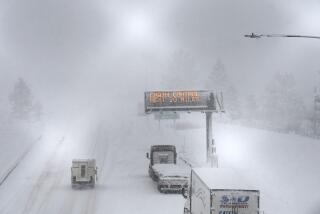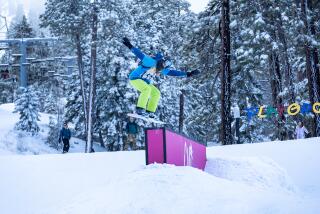In Mammoth, snow has healing power
MAMMOTH LAKES — Before we get to the early snow, the new businesses, the zipping skiers and beaming boarders at Mammoth Lakes, let’s remember how bad things have been this year for this corner of the Eastern Sierra.
First, Mother Nature delivered scant snow in the 2011-12 season, driving tourism down just as the larger economy seemed to be recovering.
Then in June, management at Mammoth Mountain, the resort that dominates the town, trimmed staff, cut salaries and announced the shuttering of its June Mountain ski operation — a painful blow to the tiny mountain community of June Lake, 20 miles north of Mammoth.
Oh, and in July the town of Mammoth Lakes declared bankruptcy after it lost a breach-of-contract lawsuit. Recovery, town officials said, would depend on layoffs, pay cuts and a plan to make debt payments of $2 million a year for 23 years.
These have been hard times, especially in June Lake, where local businesses are doing without their own ski mountain for the first time in decades.
Yet the winter of 2012-13 has begun in Mammoth Lakes with a happy bang, because nothing dilutes red ink faster than real snow.
On Nov. 8 — the same day the Mammoth resort opened its season with a handful of trails covered in manufactured snow — a storm started dumping the real thing. By the following Saturday afternoon, more than a foot of fresh power had fallen and about 2,800 skiers and boarders had hit the slopes. By Sunday six lifts were open, serving a dozen trails, and at least one local was using the word “dreamy.”
Hovering above the flocked pines, you could almost make out a community thought balloon saying: “Maybe this year ... .”
Another storm arrived the next weekend, and then another. By early December, the mountain had a base of four to six feet. A great start.
If Mammoth seems like a winter possibility but you haven’t been here for a while (or ever), here’s what I learned on a quick visit last month.
The 5-year-old Westin Monache Resort Mammoth, which stands on a hill towering over the condos, shops and restaurants of the Village, is the ritziest hotel in town. The Westin’s Whitebark bar and restaurant, a contemporary space full of dangling round stones and sleek wood paneling, is a fine venue for a round or two of drinks, but the kitchen’s too-rich fusilli didn’t do much for me.
My favorite meal, in fact, was a flavor-packed veggie lasagna at Toomey’s on Minaret Road, a tiny, year-old place that specializes in catering and takeout and looks like the Kansas City Royals’ dugout. (Toomey is a big baseball fan.) Whether you order to go or sit among the handful of tables, Toomey’s serves memorable breakfasts, lunches and dinners, from coconut mascarpone pancakes to wild buffalo meatloaf. And as locals will tell you, owner-chef Matt Toomey is already a U.S. 395 celebrity, having wowed serious eaters for more than a decade as the chef at the Whoa Nellie Deli in the Tioga Gas Mart in Lee Vining.
After a few days of nosing around, I believe I can predict that after dark in Mammoth this season, hard-partying twentysomethings will be watching snowboarding videos while doing shots amid the tiki-tinged tumult of the Lakanuki Bar in the Village, as they have for several years. Locals will be spooning up hearty albondigas soup at Roberto’s Cafe (on Old Mammoth Road), as they have for several decades.
In the morning, serious coffee consumers from near and far will queue at Black Velvet Coffee (opened this year on Main Street), a great, spare white space where baristas labor over their concoctions like post-docs solving DNA riddles. At least a few foodies will nip into Bleu Handcrafted Foods (which opened in July a few doors from Black Velvet Coffee) to gather artisan beers, wines, cheeses and meats for the larders of their rental condos.
As is often the case in ski resorts, some of the worst bargains are found closest to the slopes: A slice of pizza at the Mammoth Mountain main lodge’s slope-adjacent Broadway Marketplace costs you $5.25, and a 16.9-ounce bottle of water costs $4. (Four steps beyond the cash registers, savvy skiers and boarders get tap water in paper cups for free.) Then again, the lift line is right outside.
Mammoth Lakes was born as a ski town in the 1950s, when pioneer Dave McCoy started the resort on U.S. Forest Service land on the slopes of 11,053-foot Mammoth Mountain. The slope-side Mammoth Mountain Inn went up in 1959, and McCoy continued to build the resort and town over more than 50 years before selling the resort to Starwood Capital Group in 2005.
Nowadays the town’s year-round population is about 8,200, swelling to as many as 35,000 in winter. In town the ski area also owns the Village Lodge condo-hotel, the Juniper Springs condo-hotel and the rustic Tamarack Lodge, a haven for cross-country skiers that dates to 1924. I stayed anonymously in a pleasant one-bedroom condo at the Village Lodge, just above the shops and restaurants along the pedestrian paths of the Village at Mammoth. (Arriving on a weekday in early November, I got a rate of less than $180 a night.)
Just about every local I talked to had something to add about how and why the last few years have been tough in Mammoth — the faltering national economy, the town’s lawsuit liability (which stems from a broken promise to a developer about airport-adjacent land) and, most of all, the fickle snow.
In December 2010, on the way to a 661-inch season, the resort’s ski patrol logged about 200 inches of snow. The total for December 2011: 2 inches, on the way to a much-lamented season total of about 240 inches. (Or 263, depending on who’s counting.)
Since last winter, the Village’s Hyde Lounge nightclub and Auld Dubliner pub have closed. An upscale Italian restaurant, Campo Mammoth, is expected to open in the former Hyde space about Dec. 20. A new Greek restaurant, Jimmy’s Taverna, is expected to open soon above the Red Lantern restaurant on Old Mammoth Road.
As for the town’s municipal bankruptcy, it was officially dismissed Nov. 16, and out-of-towners are unlikely to spot any signs of it. Though the number of police in town could be cut from 17 to as few as 10, the Town Council (knowing that local government gets most of its income from taxes paid by tourists) is so far leaving hotel tax rates the same (about 13%) and continuing to pay for the free shuttle buses that carry visitors around Mammoth Lakes. Management at Mammoth Mountain continues to bankroll the shuttle buses that carry skiers and boarders four miles up the road from the town to the ski area’s main lodge.
I was surprised to hear that last summer, while the Town Council was struggling with a bankruptcy and settlement plan, many of the innkeepers and restaurateurs of Mammoth were doing pretty well, enjoying a long season of sales.
Stuart Need, owner of the Lakanuki bar, said his summer income was up about 12% over the year before. John Urdi, executive director of Mammoth Lakes Tourism, reports that the town’s hotel tax revenue from June through September hit an all-time high this year, up 6.5% from the summer before.
“The events were packed, and you couldn’t find a place to park. It was great. And it was a long summer,” said George Shirk, news editor of the Mammoth Times. Among local entrepreneurs, Shirk said, “Nobody’s complaining about the summer.”
Meanwhile, 20 miles north in June Lake, this winter looks daunting, whether snow comes or not. With about 800 residents in a community surrounded by four scenic lakes, June gets many summer fishermen and families. But for decades its winters have been dominated by June Mountain, the ski area (on U.S. Forest Service land) that has been owned by the Mammoth Mountain resort company since the 1980s.
In June, when Mammoth Mountain was struggling with the red ink from the previous low-snow winter, management decided to shut June Mountain for this winter, leaving the community’s eateries and lodgings with plenty of gorgeous scenery but no tourism centerpiece.
The embattled community responded by creating a series of homespun special events, including a village-lighting ceremony Dec. 15, a February winter-sports triathlon and a March snowmobile rally (for details, go to visitjune.com.
At June Lake’s Double Eagle Resort & Spa, owner Connie Black has cut her prevailing winter rental rates by $100 — from $369 to $269 a night for a two-bedroom cabin. At the Sierra Inn Restaurant, owner Candy Logue said she would drop prices about 15% and open only for winter weekends and holiday weeks, not regular week days. Ernie’s Tackle & Ski Shop will cut back its hours similarly.
Many in the community took comfort in Mammoth Mountain management’s vow (made in early November by Chief Executive Rusty Gregory) to reopen the June Mountain ski operation in the winter of 2013-14. But there’s no denying a difficult winter is ahead.
“Everyone’s working together to make this winter as good as we can make it,” Black said, but “there’s a fine line between optimism and hallucination.”
More to Read
Sign up for The Wild
We’ll help you find the best places to hike, bike and run, as well as the perfect silent spots for meditation and yoga.
You may occasionally receive promotional content from the Los Angeles Times.







